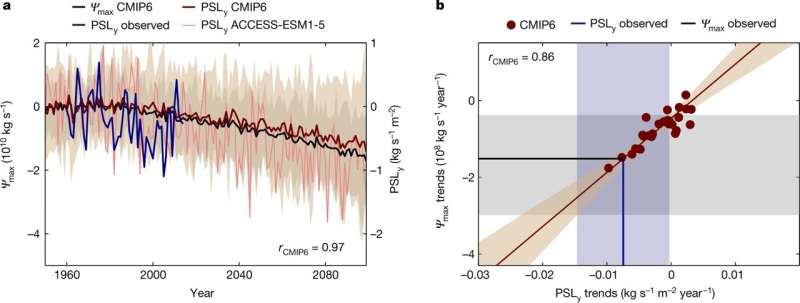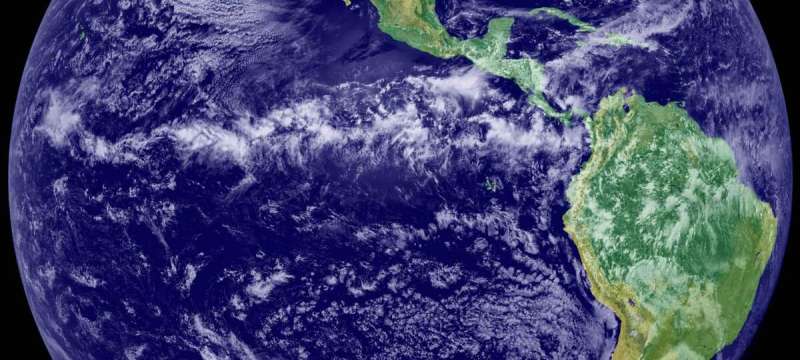Examining the role of Hadley cells in ongoing climate change

In the tropics, above the equatorial rainforests and oceans, the strong solar radiation hitting Earth propels a stream of warm, moist air far upward.
Once reaching the upper atmosphere, this stream moves in both hemispheres toward the poles; it then descends in the subtropical regions at around 20 to 30 degrees latitude, contributing to the creation of massive deserts like the Sahara in northern Africa. From there, the stream—known as the Hadley cell—returns to the equator, where it heats up and rises again, embarking on its circular journey anew.
The two Hadley cells—the northern and the southern—circulate most of the heat and humidity across low latitudes, greatly affecting the global distribution of climate regions. When the warm, moist air rises, it cools down, allowing water vapor to condense, which leads to heavy rainfall deep in the tropics.
In contrast, the streams of air that descend toward the Earth in subtropical regions are accompanied by warm, dry winds that reduce rainfall. In essence, the Hadley cells determine which regions in the tropics and the subtropics will have arid deserts and which will be blessed with abundant rainfall. Israel is located on the margins of the northern Hadley cell, which contributes to the country’s semiarid climate.
Because of their huge significance, the Hadley cells are of great interest to climate scientists. However, while there is plenty of global data about rainfall and temperature, measuring airflow throughout the atmosphere is next to impossible. Adding to the quandary, the various models seeking to make sense of the Hadley cells have been found to contradict one another.
Global climate models, which are used for climate projections, indicate that the northern Hadley cell has weakened over the past few decades, whereas observation-based analyses suggest the exact opposite.

An uncertainty over a system that is so essential to Earth’s climate detracts from the researchers’ ability to assess how much humans have contributed to recent climate change. This, in turn, undermines the credibility of climate projections, making it ever harder to formulate policies required for dealing with the climate crisis. The latest report of the Intergovernmental Panel on Climate Change, the most important document in the field, makes a special point of this issue.
In a paper published in Nature, Dr. Rei Chemke, of the Earth and Planetary Sciences Department at the Weizmann Institute of Science, and Dr. Janni Yuval, of the Massachusetts Institute of Technology, address the uncertainty that has plagued the existing models for the past two decades. They propose an observation-based method for measuring the intensity of airflow in the Hadley cells.
To tackle the challenge, Chemke and Yuval looked for readily available data they could use to formulate a new way of measuring the cells’ intensity. After examining physics equations describing airflow, they identified a relationship between the Hadley cell intensity and a constantly monitored parameter: air pressure at sea level.
They then examined observational data collected over several decades and reached the conclusion that the intensity of the northern Hadley cell has indeed been weakening—just as suggested by global climate models. Moreover, they were able to show with a high level of certainty that this weakening has been the result of human activity and will likely continue in the future.
What, then, is to be expected? Over the coming decades, the weakening of the northern Hadley cell is likely to mitigate the projected precipitation changes at low latitudes. It will act to temper both the increase of rainfall in equatorial regions and the reduction of rainfall in the subtropical regions. This tempering, however, might only reduce, but not overcome, the projected aridification and desertification of Israel.
“Our study shows that human activity is already affecting key global climate phenomena,” Chemke concludes.
“This research also improves the confidence that can be placed in climate model projections and helps us deal more accurately with climate change. In our follow-up study, we will examine whether a similar weakening in the Hadley cell has happened in the past thousand years owing to natural phenomena—and that will allow us to assess how unprecedented these human-induced changes are.”
More information:
Rei Chemke et al, Human-induced weakening of the Northern Hemisphere tropical circulation, Nature (2023). DOI: 10.1038/s41586-023-05903-1
Citation:
Examining the role of Hadley cells in ongoing climate change (2023, May 29)
retrieved 29 May 2023
from https://phys.org/news/2023-05-role-hadley-cells-ongoing-climate.html
This document is subject to copyright. Apart from any fair dealing for the purpose of private study or research, no
part may be reproduced without the written permission. The content is provided for information purposes only.
For all the latest Science News Click Here
For the latest news and updates, follow us on Google News.

